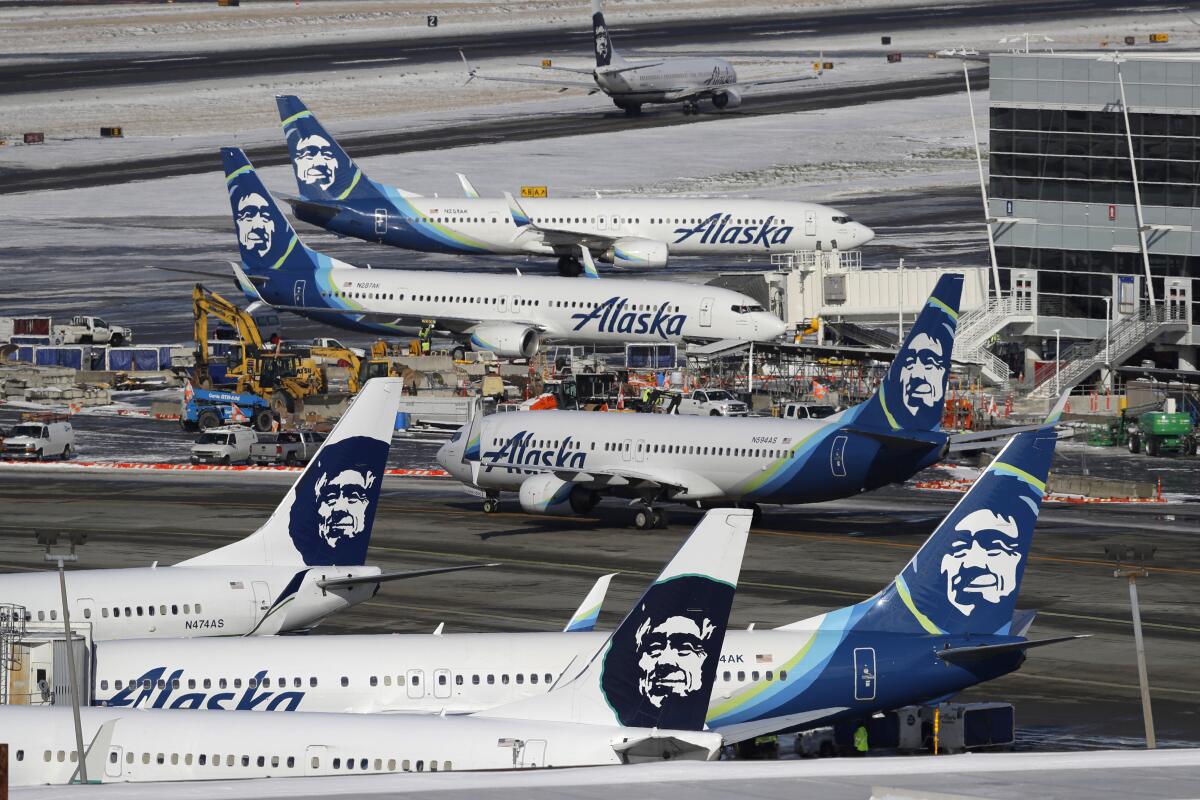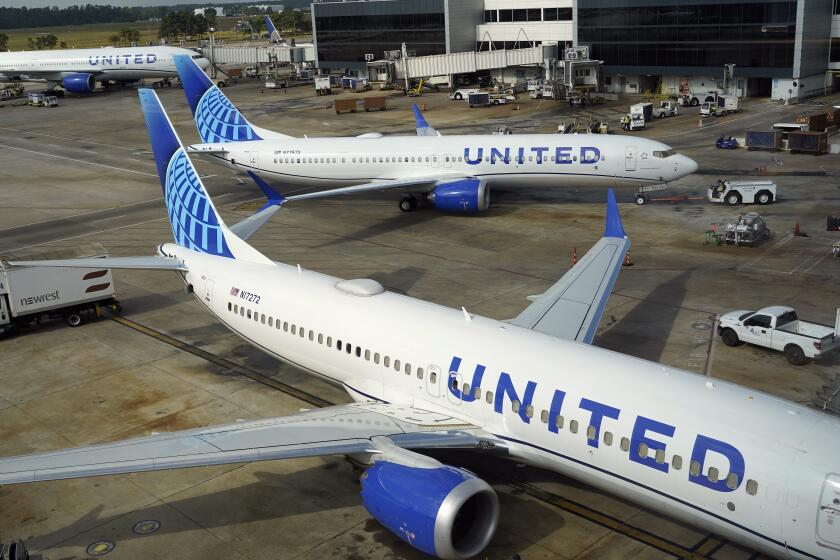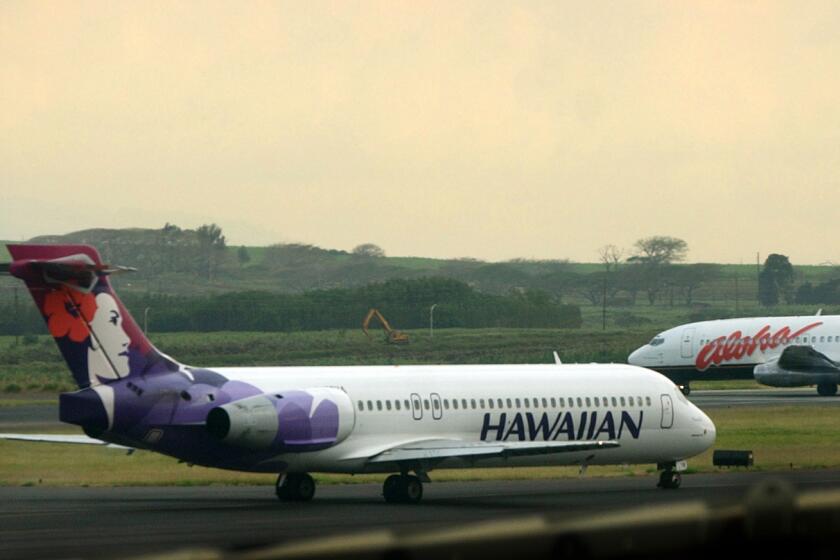Alaska Airlines flight: Cockpit audio is lost, and a mysterious warning light is investigated

- Share via
As investigators examine what caused a panel on an Alaska Airlines plane bound for Southern California to blow off midflight, forcing an emergency landing in Portland, Ore., federal officials Sunday pointed out a major obstacle: The cockpit voice recorder, or black box, from the Friday night flight was erased.
Jennifer Homendy, chair of the National Transportation Safety Board, said at a news conference that after Alaska Airlines Flight 1282 returned to Portland International Airport, no one pulled the circuit breaker on the cockpit voice recorder or otherwise preserved the audio, which holds only its most recent two hours.
“The cockpit voice recorder was completely overwritten. There was nothing on the cockpit voice recorder,” Homendy said.
Alaska and United airlines have found problems with door plugs on their Boeing 737 Max 9 jets after the blowout of the same piece of fuselage on an Alaska flight.
Among other revelations, the NTSB chief also announced that the door plug the agency had been searching for had been found by a Portland teacher. In addition, she said that prior to Friday’s midair incident, the plane had been restricted from long flights over water because of a warning light that had repeatedly gone off in the last month.
Transportation officials say the midair blowout on Alaska Airlines Flight 1282 could have been calamitous if it had happened a little later in the flight.
But Homendy was visibly exasperated by the loss of the black box recording. She noted that it was a “very chaotic event” when the plane landed and officials set up an emergency operations center.
“The maintenance team went out to get [the cockpit voice recorder], but it was right at about the two-hour mark,” she said, later adding: “We have nothing.”
Homendy emphasized that the audio could have illuminated what precisely happened when a door plug blew off as the aircraft reached an altitude of 16,000 feet. She pointed to about 10 other recent incidents when voice recorders were overwritten, including a 2017 near-catastrophe at San Francisco’s airport when an Air Canada plane almost landed on a taxiway and collided with other jets carrying about 1,000 passengers.
She called on the Federal Aviation Administration and Congress to implement a rule that would require new and existing planes to store audio for 25 hours, which aligns with European audio-retention practices.

The former Alaska Airlines pilot accused of trying to cut the engines of a Horizon Air plane in flight faces dozens of charges of endangerment.
“If that communication is not recorded, that is unfortunately a loss for us and a loss for FAA and a loss for safety,” she said, “because that information is key.”
Alaska Airlines did not respond to questions about the cockpit voice recorder or whether the airline would voluntarily install recorders that store audio for 25 hours.
The incident has forced Alaska Airlines and United Airlines to ground their Boeing 737-9 Max aircraft — and cancel hundreds of flights — while they inspect their fleets and take steps to prevent any future blowouts. Both airlines said they were working to clarify the inspection process in order to return the 737-9 Max jets to service.
On Monday, the two airlines had canceled a combined 380 flights by shortly after noon Pacific time. United canceled 233 flights, 8% of its daily schedule, and Alaska canceled 147 flights, amounting to 21% of its schedule.
Homendy also offered new details about what transpired on the Alaska Airlines flight, including that the door plug that blew off had been found in the backyard of a Portland teacher identified only by his first name.
“Thank you, Bob,” said Homendy.
Alaska Airlines agrees to buy Hawaiian Airlines in a $1.9-billion deal that could lead to a clash with a Biden administration wary of higher airfares.
The teacher contacted the NTSB through via email and sent two photos of the piece of fuselage, which was described as a 63-pound piece of the plane that is yellow-green in color on one side and white on the other. Two cellphones that plummeted from the aircraft also were found in the vicinity.
The NTSB chief revealed that Alaska Airlines had blocked the plane from being used on flights to and from Hawaii because of a warning light that had come on at least three times, possibly indicating a pressurization problem on the aircraft.
The warning light had turned on during flights on Dec. 7, Jan. 3 and Jan. 4, and each time, maintenance crews tested and then reset the light.
“We don’t know that there was any correlation” between the warning lights and what happened during Friday night’s flight, Homendy said. But Alaska Airlines had restricted that jet from transcontinental routes so that the plane could return to an airport during an emergency, she said.
Breaking News
Get breaking news, investigations, analysis and more signature journalism from the Los Angeles Times in your inbox.
You may occasionally receive promotional content from the Los Angeles Times.
Because the pressurization light had gone off several times, additional maintenance was ordered on the plane, but it had not yet been performed before Friday’s flight.
Asked to offer any theories about what caused the plane’s door plug to blow off, Homendy demurred.
“Right now we are in a fact-finding phase of the investigation,” the NTSB chief said, adding that staff were poring over the Boeing 737-9 Max aircraft for clues and planned to send key components to a lab to analyze any fractures, paint marks and shearing that could help explain what happened.
Surveying the aircraft, officials have found damage in more than a dozen rows inside but have not identified any structural damage to the aircraft. The “plug” that blew off of the plane was covering an unused emergency exit opening near Rows 25 and 26, and was essentially bolted to the aircraft structure. The plug was covered in paneling and included a window so that, from inside the cabin, it would appear indistinguishable from other rows.
A passenger plane and a Japanese coast guard aircraft collide on the runway and burst into flames, killing 5 coast guard crew members.
On Monday, investigators planned to examine the door plug on the other side of Rows 25 and 26 to try to determine what caused the other plug to blow off.
Homendy praised the flight attendants and pilots for a quick response in an environment that was terrifying and marred by communication problems.
Passengers and crew reported hearing “a bang,” she said, when the “explosive decompression” occurred after the plug was expelled from the fuselage.
“It was described as chaos, very loud,” she said. The cockpit door flew open, and the captain partly lost and first officer completely lost their respective headsets.
“Flight attendants reported that it was difficult to get information from the flight deck, and the flight deck was also having difficulty communicating,” Homendy said.
Trevor Jacob said he planned to fly solo from Lompoc City Airport to Mammoth Lakes. But investigators said he instead planned to eject himself during the flight and video record himself parachuting to the ground as his plane crashed.
The plane had six crew members and 171 passengers, including three babies and four unaccompanied minors.
“The flight attendants were very focused on what was going on with those children. Were they safe? Were they secure?”
In a stroke of luck, two seats were empty directly next to the spot where the hole opened in the plane.
Seats in that area showed signs of damage, including sheared oxygen masks, lost headrests and torquing.
“There was a lot of damage to the interior paneling and trim,” she said. “It must have been a terrifying event to experience.”
More to Read
Sign up for Essential California
The most important California stories and recommendations in your inbox every morning.
You may occasionally receive promotional content from the Los Angeles Times.

















